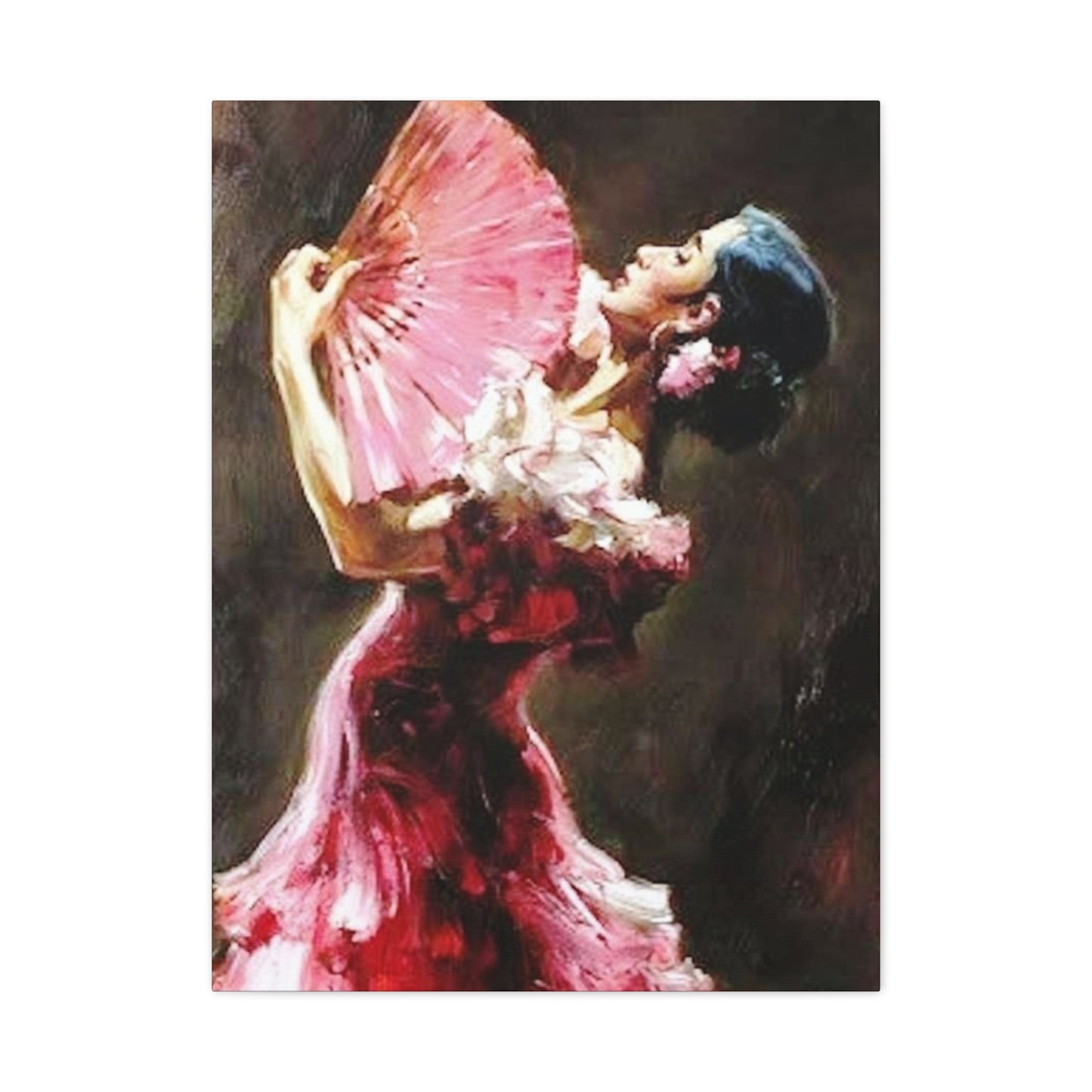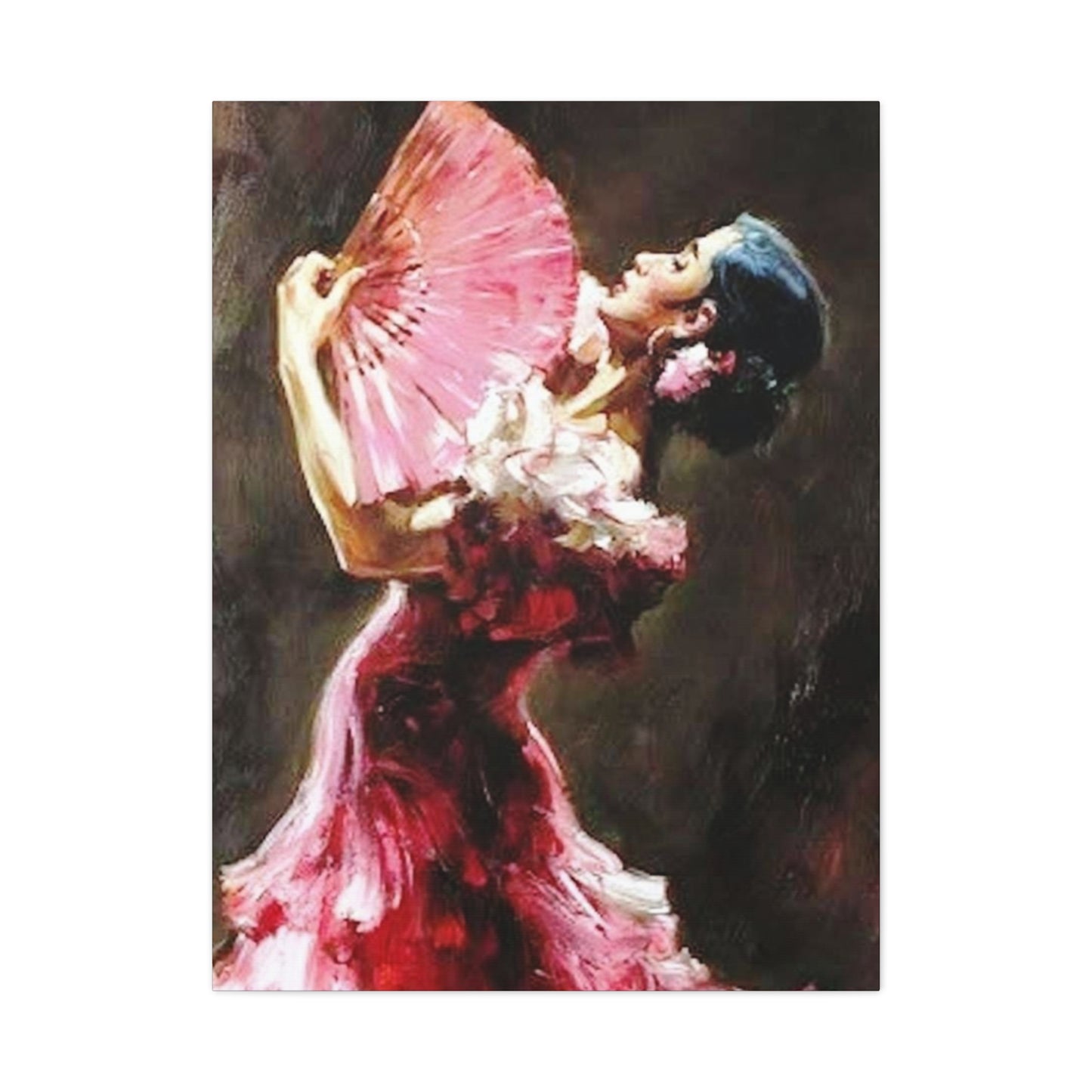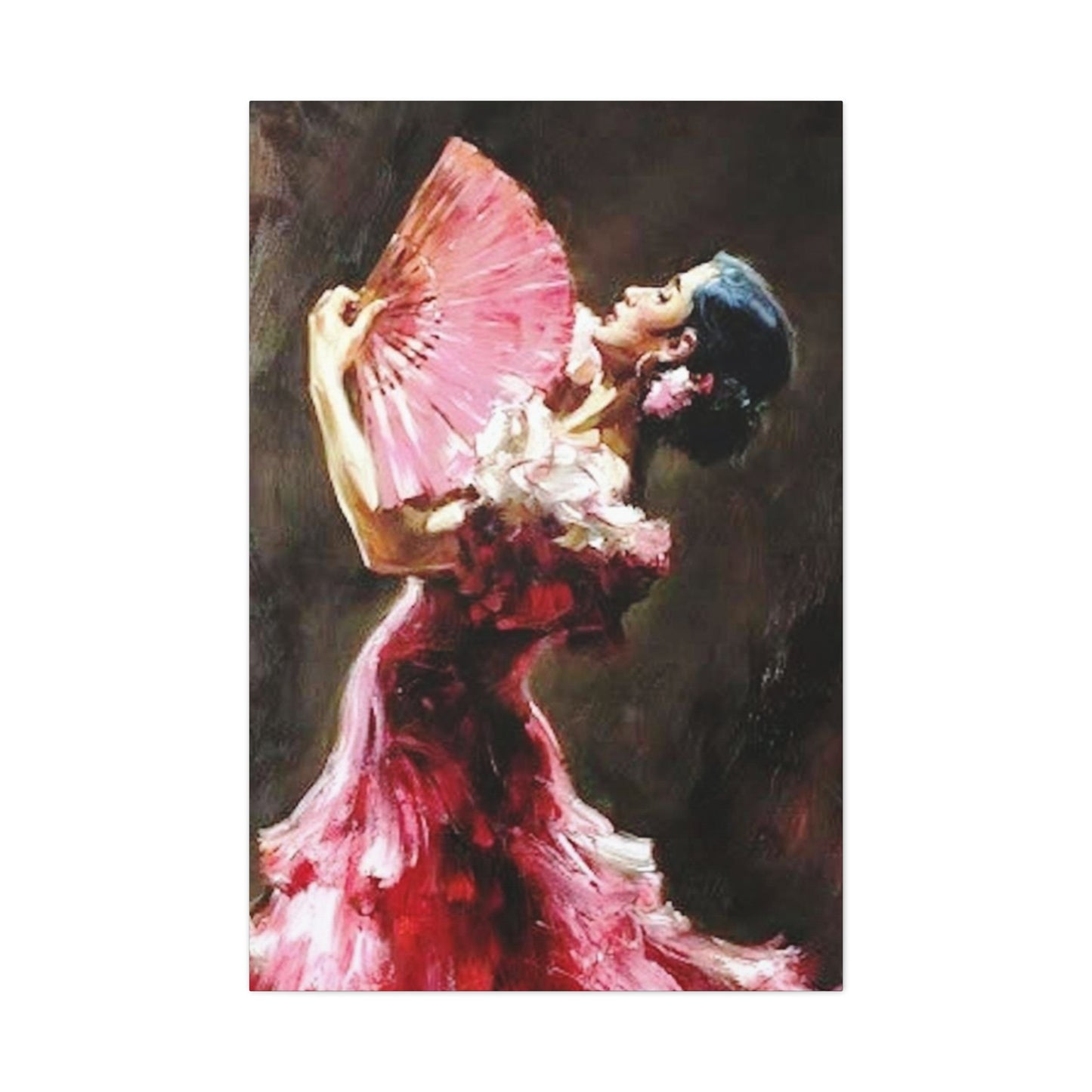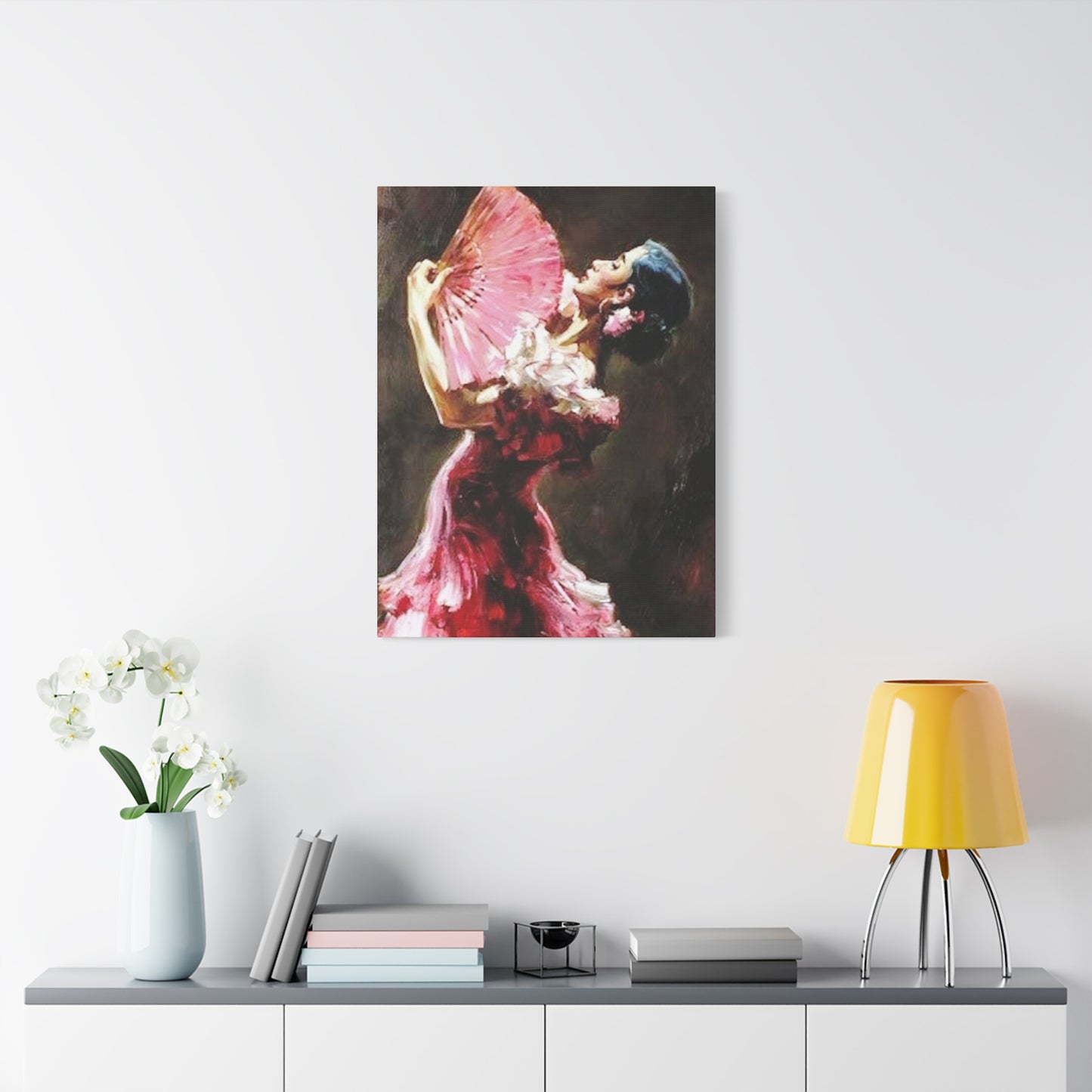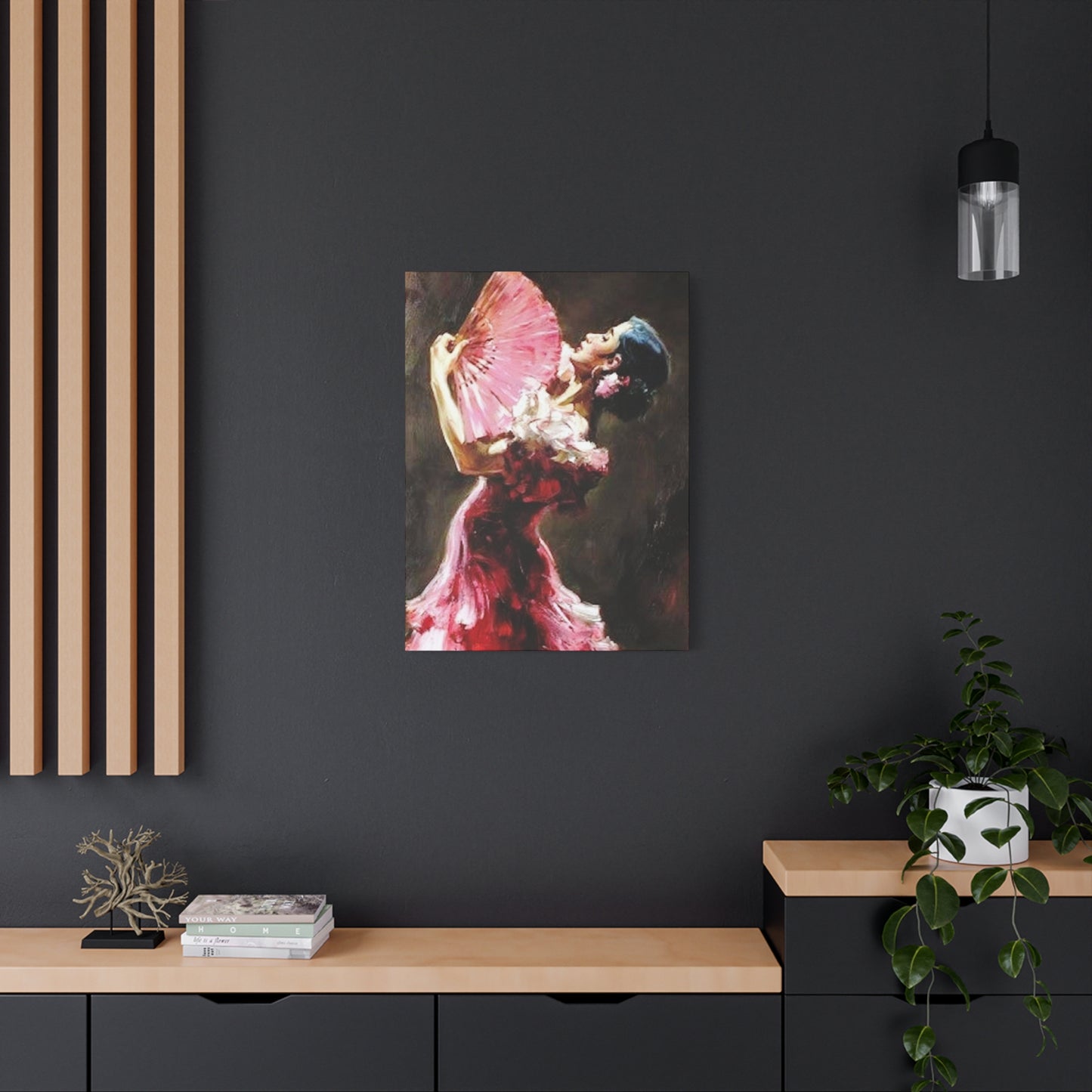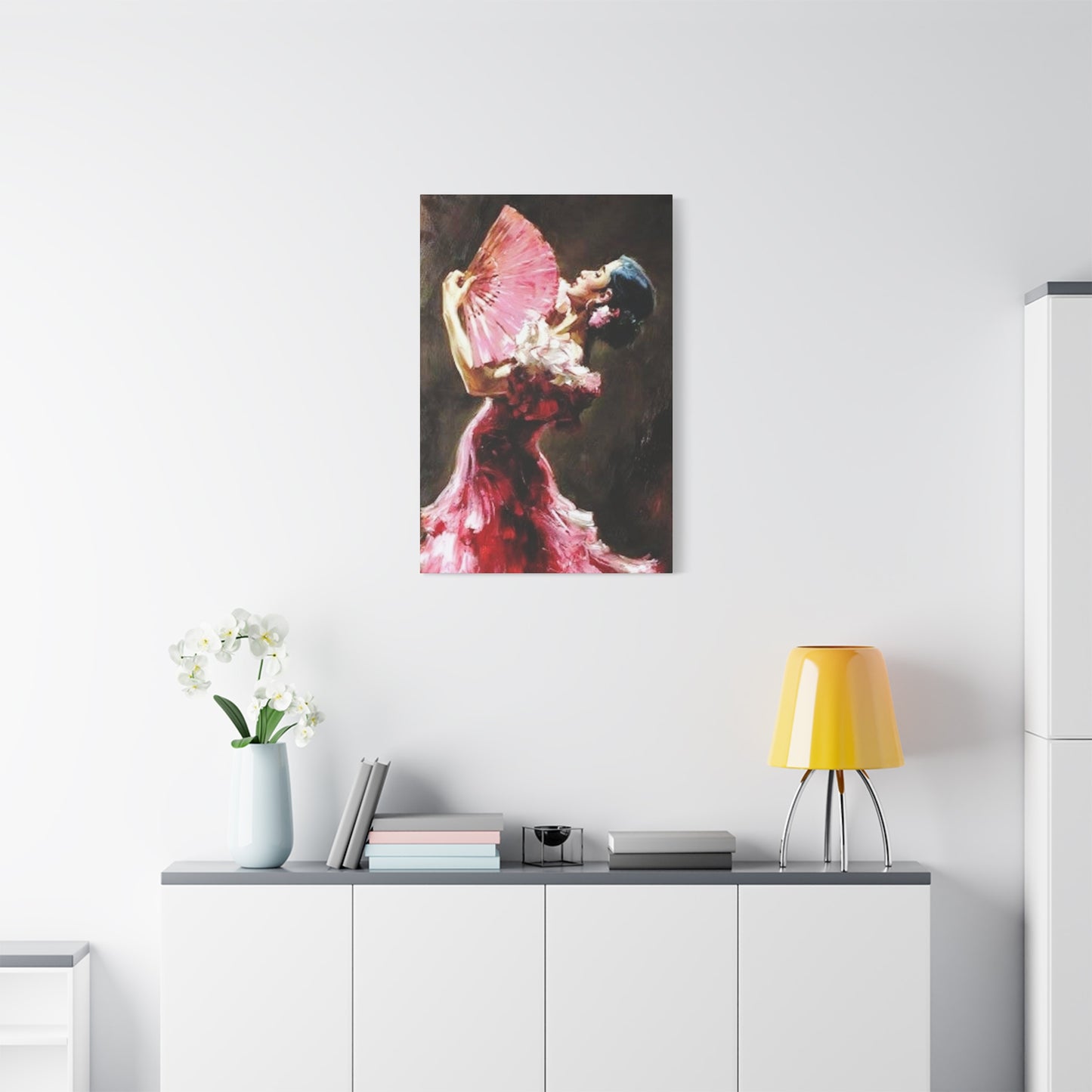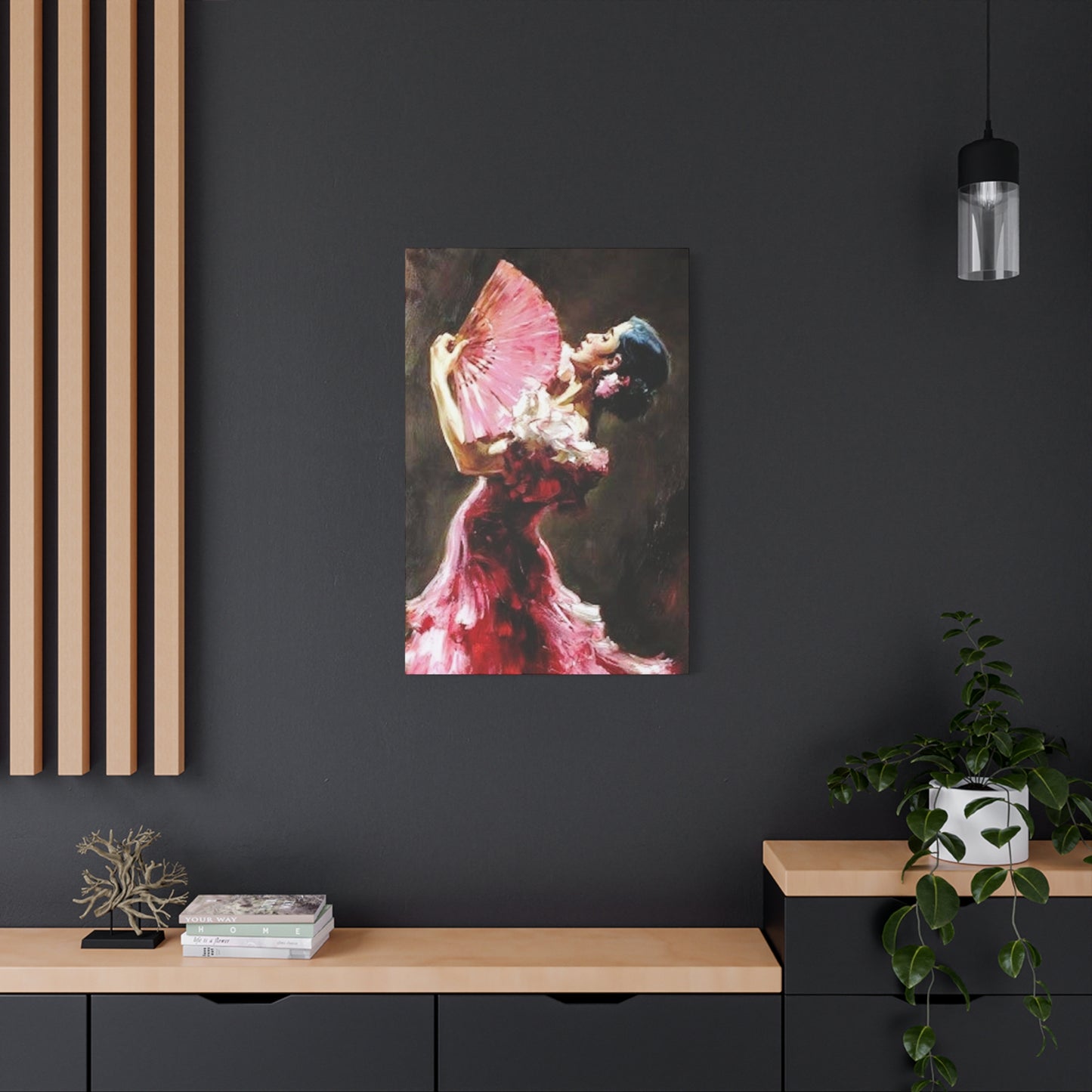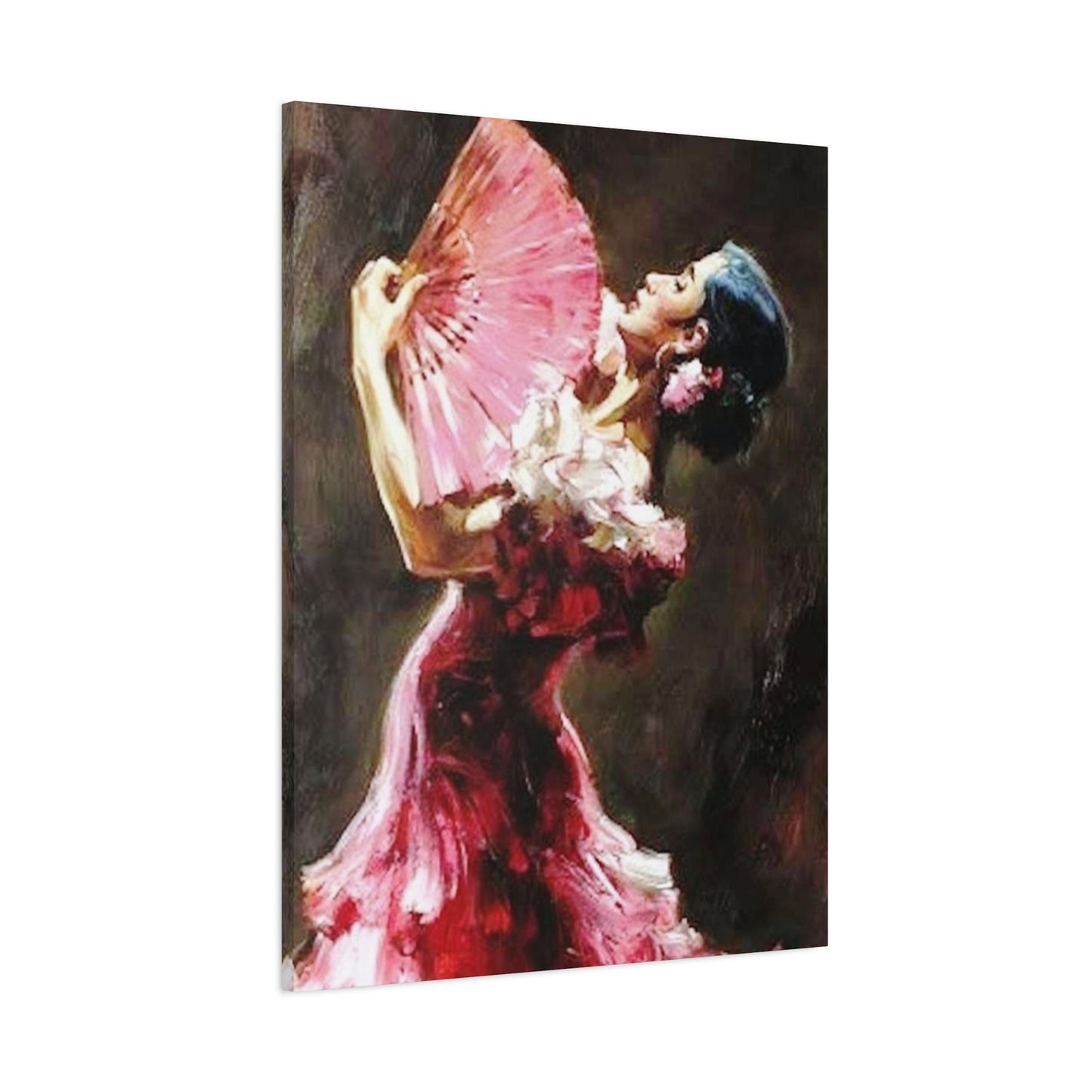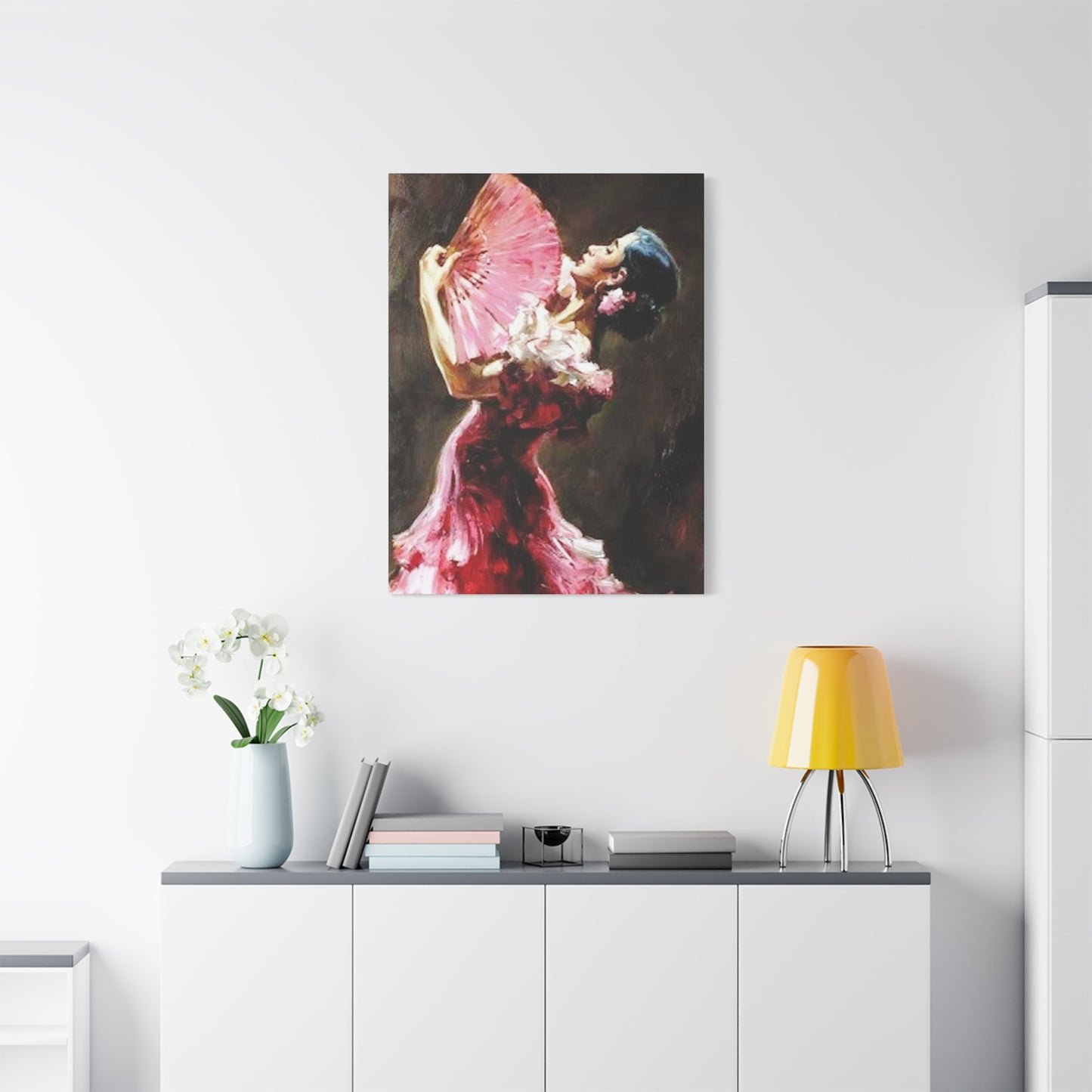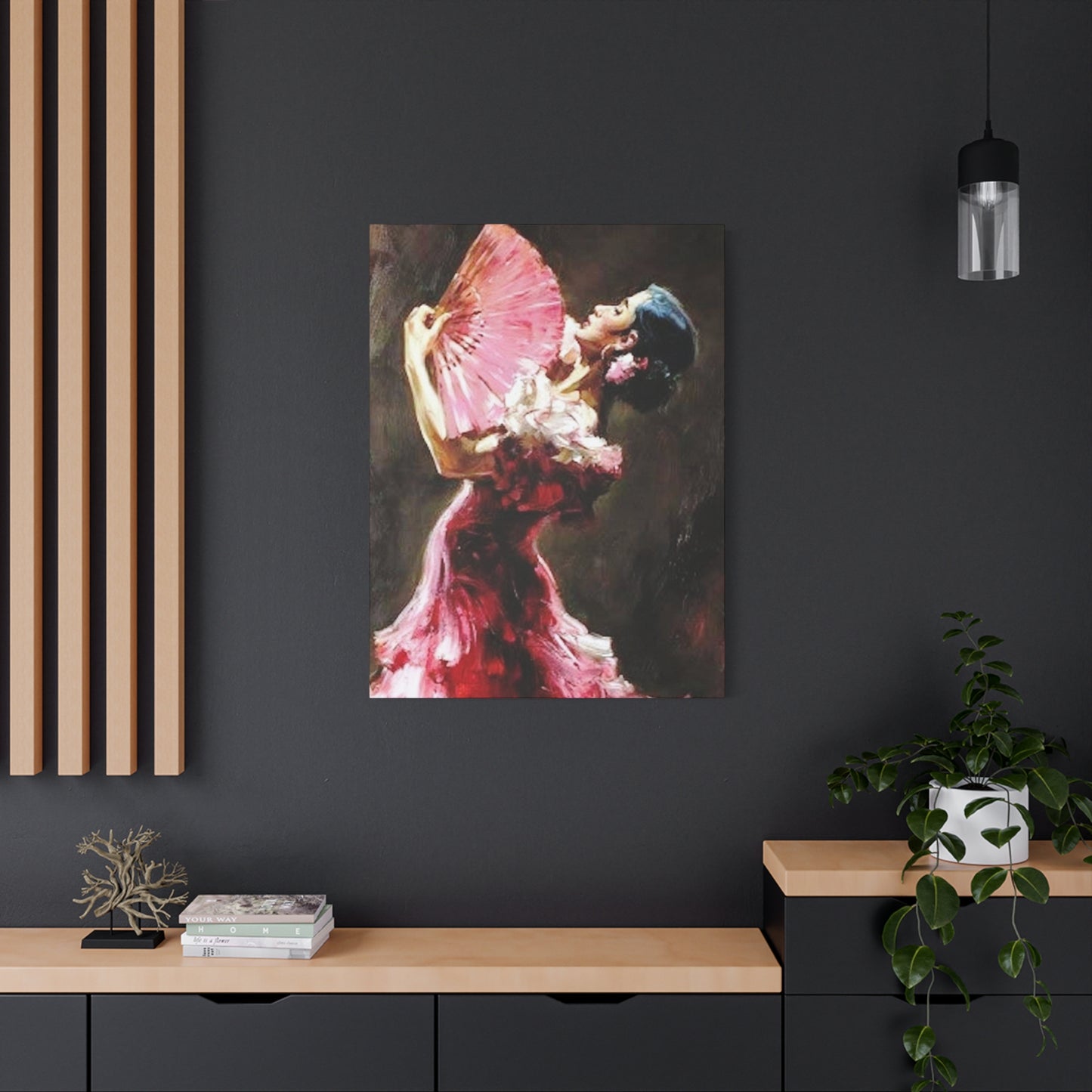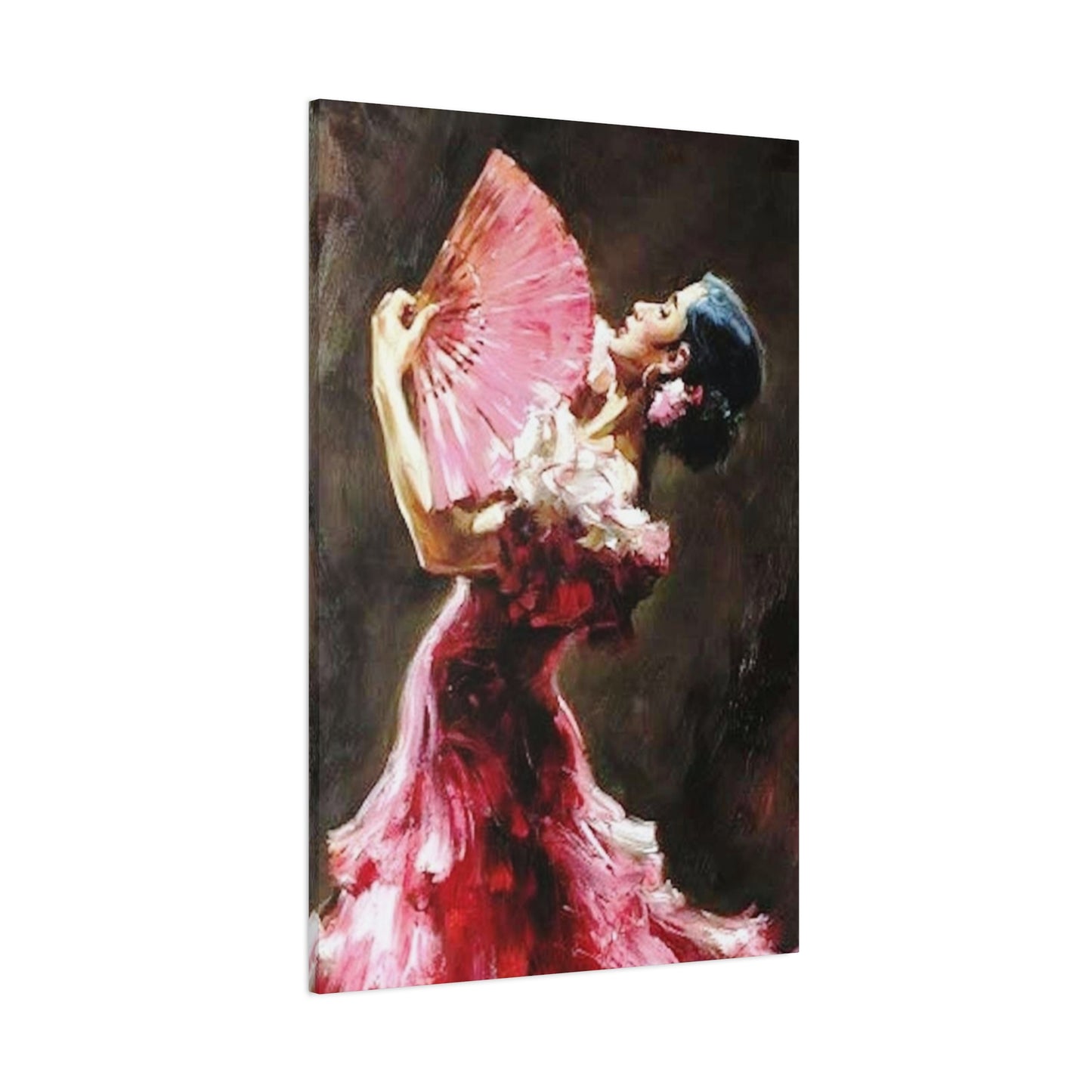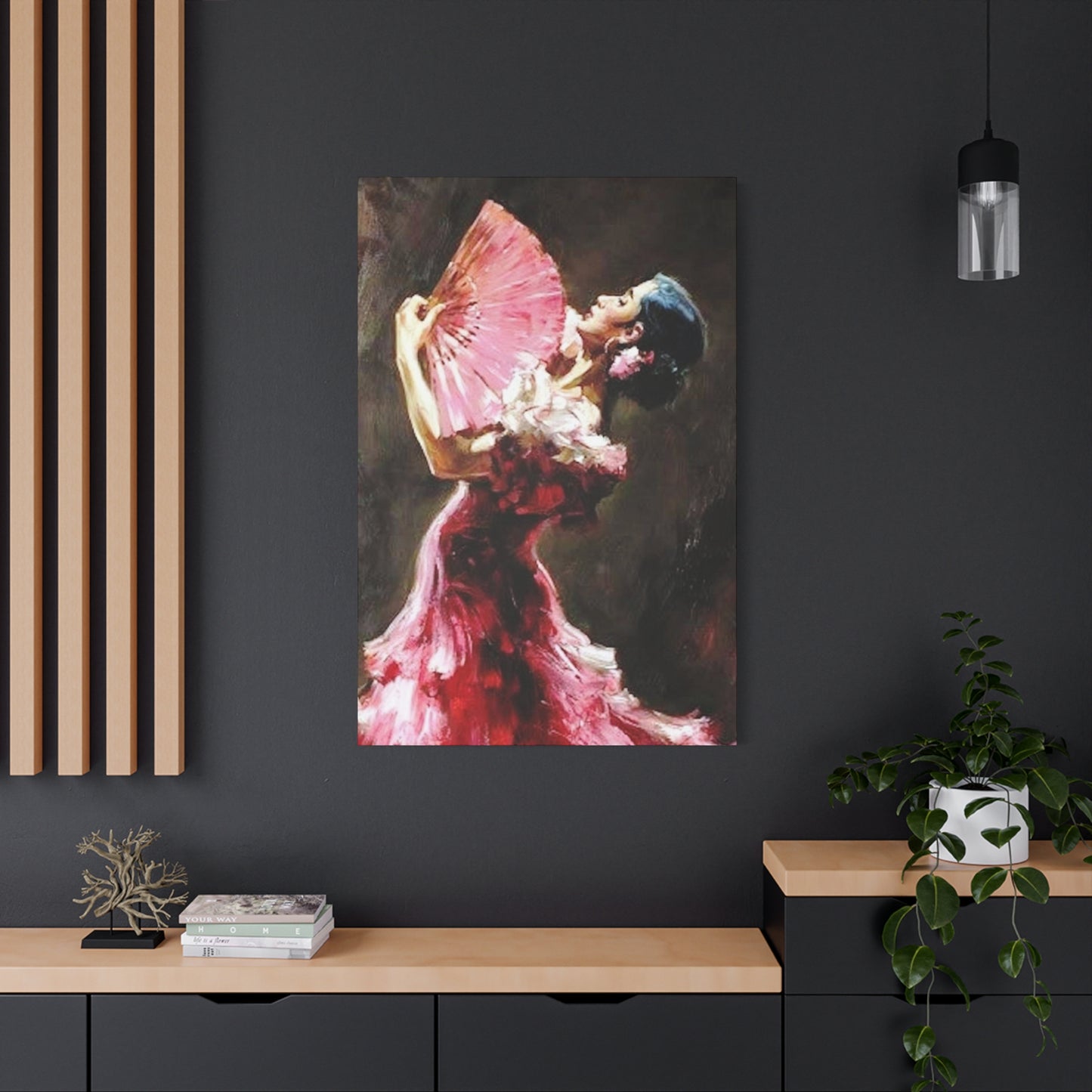The Grace of Pink: Celebrating Spain’s Traditional Dance Wear Through Wall Art
Spanish dance culture represents one of the most vibrant and passionate artistic traditions in the world, and incorporating it into your living space through wall art creates an atmosphere of elegance, energy, and cultural richness. The traditional pink dance wear of Spain, particularly associated with flamenco and regional folk dances, has become an increasingly popular choice for homeowners and interior designers seeking to infuse their spaces with Mediterranean charm and artistic sophistication.
The visual impact of Spanish traditional pink dance wear wall art extends far beyond mere decoration. These pieces capture the essence of centuries-old traditions, the grace of dancers in motion, and the romance of Andalusian culture. The soft yet vibrant pink tones commonly found in traditional Spanish dance costumes create a warm, inviting atmosphere while adding a touch of femininity and elegance to any room. This color palette works exceptionally well in various interior design schemes, from modern minimalist spaces to more traditional and eclectic environments.
When selecting wall art featuring Spanish traditional pink dance wear, you are not simply choosing a decorative element but rather inviting a piece of living history into your home. The intricate details of ruffled skirts, the dramatic poses of dancers, and the flowing movement captured in these artistic representations tell stories of passion, discipline, and cultural pride. Each piece serves as a window into the soul of Spanish performing arts, where every gesture carries meaning and every costume element has been refined over generations.
Significance of Spanish Dance Costumes
The evolution of Spanish dance costumes, particularly those in soft pink and rose tones, reflects a rich tapestry of cultural influences spanning centuries. The traditional attire worn by Spanish dancers has been shaped by Moorish occupation, Romani culture, regional folk traditions, and aristocratic fashion trends. Each element of these costumes carries historical significance, from the layered ruffles that allow for dramatic movement to the fitted bodices that showcase the dancer's posture and grace.
During the 18th and 19th centuries, Spanish dance costumes began to take on the forms we recognize today. The bata de cola, a traditional flamenco dress with a long train, became iconic in Andalusian dance culture. While red has been the most traditionally associated color with flamenco, pink variations emerged as dancers and designers sought to express different emotional qualities and appeal to diverse audiences. Pink dance wear often represented youth, romance, and a softer interpretation of the passionate art form.
The construction of traditional Spanish dance costumes demonstrates remarkable craftsmanship. Multiple layers of ruffled fabric create the characteristic volume and movement that makes these garments so visually striking. When dancers spin and execute their footwork, the skirts create mesmerizing patterns of color and motion. This dynamic quality translates beautifully into wall art, where artists capture frozen moments of this movement, preserving the energy and grace in a static medium.
Regional variations in Spanish dance costumes also contribute to the diversity of imagery available in wall art. From the sevillanas dresses of Andalusia to the traditional attire of Valencian folk dances, each region has developed its own distinctive style. The use of pink in these costumes varies by region and occasion, with lighter shades often reserved for spring festivals and deeper rose tones for more formal performances. This variety allows art collectors and homeowners to select pieces that resonate with specific aspects of Spanish cultural heritage.
Flamenco Dance Tradition and Its Visual Legacy
Flamenco dance stands as one of Spain's most internationally recognized cultural exports, and its visual aesthetic has profoundly influenced decorative arts worldwide. The dramatic poses, intense emotional expression, and spectacular costumes of flamenco dancers provide endless inspiration for artists creating wall art. When rendered in pink tones, flamenco imagery takes on a unique character that balances the art form's inherent intensity with a softer, more approachable aesthetic.
The technical precision required in flamenco dance translates into visually stunning moments perfect for artistic capture. The arched back of a bailaora, the sharp angles of raised arms, and the focused intensity of facial expressions create compositions that command attention. Artists specializing in Spanish dance imagery understand how to freeze these moments in ways that convey both the stillness of art and the implied motion of dance. The pink color palette adds warmth and accessibility to these powerful images.
Flamenco's musical and rhythmic complexity finds visual expression in the movement of dance costumes. The compás, or rhythmic cycle, of flamenco music dictates the dancer's movements, and skilled artists can suggest this rhythm through the depiction of flowing fabric and strategic positioning. Wall art featuring pink flamenco wear often captures moments between beats, where the dancer is poised in anticipation or completing a dramatic flourish, creating a sense of suspended animation that draws viewers into the performance.
The emotional depth of flamenco, ranging from profound sorrow to exuberant joy, provides rich subject matter for artistic interpretation. Pink dance wear in wall art often represents the more romantic and joyful aspects of flamenco, such as alegrías or bulerías, rather than the deeper lament of soleá. This emotional association makes such artwork particularly suitable for spaces where positive energy and uplifting aesthetics are desired.
Selecting the Perfect Spanish Dance Wall Art for Your Space
Choosing the right piece of Spanish traditional pink dance wear wall art requires consideration of multiple factors, from room dimensions and existing decor to personal aesthetic preferences and the emotional atmosphere you wish to create. The selection process should balance practical considerations with the more intuitive responses that artwork naturally evokes.
Scale represents one of the most critical factors in art selection. A piece that is too small for a wall will appear lost and fail to make the intended impact, while oversized art in a confined space can feel overwhelming. For Spanish dance wear wall art, consider the dynamic nature of the subject matter. Images with dramatic movement and flowing costumes often benefit from generous sizing that allows viewers to appreciate the details and energy of the composition. A general guideline suggests that wall art should occupy roughly two-thirds to three-quarters of the available wall space for optimal visual impact.
The style of artistic rendering significantly affects how Spanish dance wear art integrates into different interior design schemes. Photographic representations offer realistic detail and can work beautifully in modern, contemporary settings. Painted interpretations, whether in oil, acrylic, or watercolor, bring artistic interpretation and can range from highly realistic to impressionistic or abstract. Digital art and prints offer affordability and variety. The pink tones in dance wear can be rendered in naturalistic ways or heightened for dramatic effect, depending on the artistic approach.
Consideration of existing color schemes ensures harmonious integration of new wall art. Spanish traditional pink dance wear art works particularly well with neutral palettes of whites, creams, and grays, where it provides a focal point of color and interest. It also complements natural wood tones, creating a warm, organic aesthetic. For rooms with existing color schemes, consider how the pink tones in the artwork relate to other colors present. Complementary colors like soft greens or teals can create sophisticated pairings, while analogous warm tones create cohesive, flowing color stories.
Lighting conditions in the intended display space affect how artwork appears and how well its details can be appreciated. Spanish dance wear wall art typically benefits from good lighting that allows the subtleties of fabric texture, movement, and color gradation to be fully appreciated. Consider both natural light throughout the day and artificial lighting options. Dedicated art lighting can dramatically enhance the viewing experience while also protecting the artwork from damage.
Artistic Styles and Mediums for Spanish Dance Imagery
The representation of Spanish traditional pink dance wear in wall art spans an impressive range of artistic styles and mediums, each offering distinct aesthetic qualities and suited to different design sensibilities. From classical oil paintings to modern digital creations, the medium chosen significantly impacts the artwork's character and its interaction with surrounding decor.
Traditional oil painting remains one of the most prestigious and sought-after mediums for Spanish dance imagery. The rich texture and depth achievable with oil paints allow artists to create luminous, dimensional representations of pink dance costumes with remarkable realism. The way oil paint can capture the play of light on satin fabric or the delicate transparency of lace overlays makes it particularly effective for this subject matter. Oil paintings also carry an inherent sense of permanence and artistic value that appeals to serious collectors and those seeking investment-quality art pieces.
Watercolor interpretations of Spanish dance wear offer a different aesthetic entirely, one characterized by fluidity, transparency, and a certain ethereal quality. The medium's inherent unpredictability creates organic variations and soft color transitions that beautifully echo the flowing movement of dance. Pink watercolor washes can create dreamy, romantic representations of dancers that feel lighter and more delicate than their oil-painted counterparts. This style works exceptionally well in spaces seeking a softer, more feminine aesthetic.
Acrylic paintings combine some advantages of both oil and watercolor, offering vibrant color saturation and versatility in application techniques. Artists working in acrylics can create everything from highly detailed realistic works to bold, expressionistic interpretations. The medium's quick drying time allows for layering and texture building that can effectively represent the complex construction of traditional Spanish dance costumes. Acrylic works often offer a more contemporary feel while remaining affordable compared to oil paintings.
Photographic art provides documentary realism and captures authentic moments from actual performances or styled photoshoots. High-quality photography of Spanish dancers in traditional pink attire offers viewers a direct connection to real performers and actual costumes. Digital enhancement and various printing techniques can transform photographs into art pieces that range from straightforward documentary images to heavily stylized creations. Photography particularly appeals to those who value authenticity and want their wall art to represent real rather than imagined scenes.
Regional Spanish Dances and Their Distinctive Costumes
While flamenco dominates international perceptions of Spanish dance, the country's diverse regions each maintain distinct dance traditions with unique costume styles. Wall art featuring these regional variations provides opportunities to celebrate specific aspects of Spanish cultural heritage while offering diverse aesthetic options for home decor.
Sevillanas, the folk dances of Seville, feature distinctive costumes that epitomize Andalusian style. The traditional dress, called traje de flamenca or traje de gitana, consists of a fitted bodice and a long, ruffled skirt with multiple tiers. Pink variations of sevillanas dresses appear frequently during the Feria de Abril, Seville's famous spring fair. Wall art depicting sevillanas dancers in pink attire captures the festive, joyful spirit of these celebrations, with dancers often shown in pairs, reflecting the social nature of this dance form.
The sardana of Catalonia presents a completely different aesthetic, with traditional costumes reflecting the region's distinct cultural identity. While not typically featuring the dramatic ruffles of Andalusian dance wear, sardana costumes have their own elegant simplicity. When rendered in pink tones, these costumes offer a more understated option for wall art that still celebrates Spanish dance tradition but with a refined, minimalist quality suited to contemporary interiors.
Valencian folk dances showcase elaborate regional costumes with significant historical elements. The traditional fallera dress, worn during Las Fallas festival, features fitted silhouettes, elaborate embroidery, and distinctive silhouettes. While traditional versions typically use specific color combinations, artistic interpretations in pink create romantic variations that maintain the costume's structural integrity while offering fresh color perspectives. These representations work particularly well in spaces seeking to balance tradition with personal aesthetic preferences.
The jota, performed across multiple Spanish regions but particularly associated with Aragon, features costumes that vary by locality but generally maintain folk dance characteristics. The female costumes often include colorful skirts, embroidered bodices, and regional accessories. Pink interpretations of jota costumes in wall art provide opportunities to celebrate less internationally known aspects of Spanish dance culture while maintaining broad visual appeal.
Creating Gallery Walls with Spanish Dance Themes
The gallery wall concept has become increasingly popular in contemporary interior design, offering a dynamic way to display multiple artworks in a cohesive yet varied arrangement. Creating a gallery wall centered around Spanish traditional pink dance wear provides opportunities for creative expression while celebrating this artistic tradition through multiple perspectives and styles.
The foundation of a successful gallery wall lies in establishing a unifying theme while maintaining sufficient variety to create visual interest. With Spanish dance wear as your central theme, you can incorporate different artistic styles, sizes, and specific dance forms while the pink color palette and subject matter provide continuity. Consider mixing photographic pieces with painted works, combining close-up details of costume elements with full-figure dancer portraits, or pairing action shots with more contemplative poses.
Layout planning requires careful consideration before hanging begins. Create a template using craft paper cut to the sizes of your intended artworks, then arrange and rearrange these on the wall until you achieve a pleasing composition. Traditional grid arrangements create formal, organized presentations, while more organic, salon-style arrangements offer dynamic, collected-over-time aesthetics. For Spanish dance imagery, consider arrangements that suggest movement, with pieces positioned to create visual flow across the wall.
Color coordination within a gallery wall dedicated to pink Spanish dance wear involves balancing consistency with variation. While all pieces feature pink dance costumes, the specific shades, intensities, and proportions of pink to other colors will vary. Arrange pieces so that color creates rhythmic patterns across the wall rather than clustering all similar tones together. This approach creates visual movement that echoes the dance theme itself.
Frame selection significantly impacts gallery wall cohesion. Consistent framing creates unity even when artwork varies considerably in style and content. For Spanish dance imagery, consider frames that complement rather than compete with the artwork. Simple black or white frames often work well, allowing the colorful costumes to command attention. Alternatively, warm wood tones can enhance the Mediterranean feel of Spanish dance imagery. Mat boards in neutral tones provide breathing room around images while ensuring consistency across the collection.
The Role of Movement in Static Dance Art
One of the most fascinating challenges in creating or selecting wall art featuring Spanish traditional pink dance wear involves capturing the essence of movement in a static medium. Dance exists as a time-based art form, unfolding through sequences of motion, yet wall art must distill this dynamic quality into a single frozen moment. The most successful pieces achieve this paradox through careful composition, implied motion, and strategic capture of peak moments.
Artists employ various techniques to suggest movement in dance imagery. The positioning of flowing costume elements like ruffled skirts and long trains creates directional energy that implies recent or imminent motion. When a dancer's skirt is captured mid-spin, the fabric's radial arrangement and blur effects suggest rotational movement even in stillness. These visual cues allow viewers' minds to reconstruct the motion that preceded and will follow the captured moment.
The dancer's body position and gesture also convey movement and intention. A raised arm frozen at the apex of its arc suggests the upward motion that preceded it and the descent that will follow. The angle of a tilted head, the curve of a back, or the positioning of fingers in traditional flamenco hand positions all communicate specific moments within dance sequences. Viewers familiar with Spanish dance can mentally place these frozen moments within complete choreographic phrases, while those less familiar still sense the implied motion.
Facial expression contributes significantly to the sense of movement and life in dance imagery. The concentrated focus of a performer mid-routine, the joy of festive dancing, or the dramatic intensity of flamenco storytelling all animate the image. When combined with pink costume elements, these expressions can convey everything from playful romance to powerful passion, depending on the specific captured moment and the dancer's emotional projection.
Cultural Authenticity and Artistic Interpretation
When selecting or commissioning wall art featuring Spanish traditional pink dance wear, questions of cultural authenticity and artistic interpretation naturally arise. Balancing respect for authentic tradition with creative freedom and personal aesthetic preferences requires thoughtful consideration and awareness of the cultural significance embedded in Spanish dance traditions.
Authentic representation of Spanish dance costumes involves understanding their historical development, regional variations, and cultural context. Traditional flamenco and folk dance costumes evolved over centuries, with specific construction techniques, embellishment patterns, and wearing conventions. Artists who study these traditions and work with actual dancers or costume designers create works that honor this heritage while still exercising creative vision. These authentic representations carry educational value alongside their aesthetic appeal.
Artistic interpretation allows creative freedom that can make Spanish dance imagery accessible and appealing to broader audiences while potentially diverging from strict authenticity. An artist might emphasize color, exaggerate movement, simplify costume details, or place dancers in imaginative rather than realistic settings. Pink dance wear might be rendered in shades that never appear in actual traditional costumes but create desired aesthetic effects. These interpretations celebrate the spirit and energy of Spanish dance while serving primarily as decorative art.
The spectrum between documentary realism and abstract interpretation offers multiple valid approaches to Spanish dance wall art. Photography tends toward the documentary end, capturing real performers in authentic costumes. Traditional painting styles can represent real scenes with varying degrees of artistic interpretation. More expressionistic and abstract approaches use Spanish dance as inspiration but prioritize artistic vision over cultural accuracy. Understanding where a piece falls on this spectrum helps ensure it aligns with your intentions for displaying it.
Cultural appreciation versus cultural appropriation represents an important consideration in contemporary art and decor. Displaying Spanish dance imagery as wall art typically represents appreciation when approached with respect for the tradition's significance. However, context matters. Combining such imagery with complementary Spanish cultural elements, acknowledging the tradition's origins, and selecting pieces from artists who demonstrate cultural understanding all contribute to respectful appreciation rather than superficial appropriation.
Supporting authentic voices in Spanish dance art means seeking out Spanish artists, artists with deep connections to Spanish dance culture, or those who collaborate with Spanish dance communities. Many contemporary Spanish artists create stunning interpretations of their cultural heritage that bring insider perspectives and lived experience to their work. Purchasing from these artists ensures both cultural authenticity and economic support for communities connected to these traditions.
Framing and Presentation Techniques
The framing and presentation of Spanish traditional pink dance wear wall art significantly affects its visual impact and longevity. Thoughtful framing choices enhance the artwork while protecting it from environmental damage, creating a finished presentation that integrates seamlessly with your interior design scheme.
Frame style selection should complement both the artwork and the surrounding space. Traditional wooden frames with carved or gilded details suit classical oil paintings of Spanish dancers and work beautifully in traditional or eclectic interiors. Simple, clean-lined frames in black, white, or natural wood create contemporary presentations that allow the artwork to dominate attention. For Spanish dance imagery, consider how frame style interacts with the costume details depicted. Ornate frames can echo the elaborate nature of traditional dance costumes, while minimalist frames create striking contrast with intricate imagery.
Mat board use provides several important functions beyond pure aesthetics. A mat creates visual breathing room between the artwork and frame, preventing the image from feeling cramped. For Spanish dance art featuring pink costumes, neutral mat colors typically work best, allowing the pink tones to remain the focal point. Cream and off-white mats create warmth, while pure white provides crisp contrast. Multiple mats in complementary colors can create more elaborate presentations, but simpler approaches often prove most effective for allowing the dance imagery to shine.
Glass or acrylic glazing protects artwork from dust, humidity, and physical damage while affecting how it appears. Standard glass provides basic protection but can create glare problems depending on lighting and viewing angles. Non-reflective or museum glass significantly reduces glare, making the artwork more visible under various lighting conditions. This option particularly benefits detailed photography or fine art prints where maximum clarity enhances appreciation. UV-protective glazing prevents light damage that causes fading, essential for preserving the vibrant pink tones in Spanish dance wear imagery over time.
Conservation framing techniques ensure long-term artwork preservation. Acid-free materials prevent chemical reactions that cause yellowing and deterioration. Proper spacing between artwork and glazing prevents condensation damage and allows air circulation. For valuable or irreplaceable pieces featuring Spanish dance imagery, professional conservation framing represents a worthwhile investment that protects your artwork for generations.
Complementary Decor Elements for Spanish-Themed Spaces
Creating a cohesive design environment around Spanish traditional pink dance wear wall art involves selecting complementary decor elements that enhance the aesthetic without creating visual competition or thematic confusion. A thoughtfully curated space balances cultural specificity with personal style, creating an environment that feels intentional rather than costume-like.
Color palette development starts with the pink tones in your featured artwork and expands outward. Neutral base colors like warm whites, creams, and sandy beiges provide a canvas that allows Spanish dance imagery to remain the focal point while creating a light, airy Mediterranean feel. Accent colors drawn from Spanish cultural associations include terracotta oranges, deep burgundies, sunny yellows, and various earth tones. These can appear in smaller doses through pillows, throws, or decorative objects, creating color harmony without overwhelming the space.
Textile selection offers opportunities to reinforce Spanish aesthetic themes. Consider incorporating fabrics with subtle texture or pattern that echoes elements of traditional Spanish textiles without directly replicating costume materials. Linen in natural tones creates casual Mediterranean elegance. Cotton throws in complementary colors add comfort and visual interest. For bolder statements, small amounts of fabric featuring traditional Spanish patterns can work, but use restraint to prevent the space from feeling like a themed restaurant.
Furniture choices should support rather than compete with Spanish dance wall art. Spanish and Mediterranean furniture styles feature warm wood tones, curved lines, and substantial construction. Wrought iron elements in light fixtures, table bases, or decorative objects reference traditional Spanish metalwork without requiring wholesale furniture replacement. Even in contemporary spaces, selecting a few pieces with Spanish or Mediterranean influences can strengthen the overall design narrative.
Decorative objects provide opportunities for cultural storytelling. A collection of decorative fans displayed on a shelf or wall nods to Spanish dance without being literal. Ceramic pieces in traditional Spanish styles add color and craftsmanship. Books about Spanish culture, photography collections of Spanish regions, or novels set in Spain can occupy coffee tables or shelves, adding intellectual depth to the aesthetic choices.
Lighting design significantly affects how Spanish dance wall art appears and how the overall space feels. Warm lighting temperatures create the golden glow associated with Mediterranean environments. Decorative lighting with Spanish or Moorish influences, such as pierced metal lanterns or tiles fixtures, reinforces cultural themes. Ensure your Spanish dance artwork receives adequate illumination to appreciate its details and colors fully.
Spanish Dance Art in Different Room Settings
The versatility of Spanish traditional pink dance wear wall art allows it to enhance various room types, each presenting unique opportunities and considerations for effective integration. Understanding how dance imagery functions in different spaces helps ensure both aesthetic success and appropriate contextual fit.
Living rooms serve as primary gathering spaces where Spanish dance wall art can make strong style statements. Large-scale pieces create focal points above sofas or fireplaces, commanding attention and setting the room's aesthetic tone. The energy and movement captured in dance imagery animate living spaces, creating conversation starters and establishing sophisticated, culturally aware design sensibilities. Pink tones in the artwork can inform the room's broader color scheme, with accent pillows, throws, or floral arrangements echoing these hues. Living rooms also accommodate gallery wall arrangements of Spanish dance imagery, allowing for more complex visual narratives.
Dining rooms benefit from the celebratory, festive quality of Spanish dance imagery. Traditional Spanish culture places enormous emphasis on gathering for meals, making dance-themed art contextually appropriate for dining spaces. The dramatic flair of Spanish dance costumes suits the formal quality many dining rooms maintain. Positioning Spanish dance wall art where it's visible from the dining table creates visual interest during meals without causing distraction. Pink tones can complement table settings and create warm, inviting atmospheres conducive to extended dining experiences characteristic of Spanish meal traditions.
Bedrooms offer intimate settings where Spanish traditional pink dance wear wall art creates romantic, feminine environments. The softer pink tones available in this art category work particularly well in bedroom contexts, promoting relaxation while maintaining visual interest. Positioning dance imagery above the bed as a headboard alternative creates a focal point that balances restfulness with artistic energy. Smaller pieces on side walls or dressing areas add personality without overwhelming the space. The passionate yet elegant nature of Spanish dance suits the private, personal character of bedrooms while the pink palette supports tranquil atmospheres.
Home offices and study spaces gain personality and inspiration from Spanish dance wall art. These work environments benefit from imagery that stimulates creativity while avoiding distraction. Spanish dance art introduces cultural richness and artistic beauty that makes professional spaces feel more personal and engaging. The discipline and dedication required in dance can serve as inspirational metaphors for focused work. Positioning artwork where it's visible during breaks rather than directly in primary sightlines maintains productivity while providing visual respite when needed.
Entryways and hallways create first impressions and transition spaces where Spanish traditional pink dance wear wall art establishes home character immediately. These areas often suffer from design neglect despite their importance in shaping visitor perceptions. A statement piece of Spanish dance art in an entry creates memorable impact and signals sophisticated aesthetic sensibilities. Hallway gallery walls featuring multiple Spanish dance pieces transform utilitarian passages into artistic experiences. The vertical emphasis of many dance poses suits the proportions of hallway spaces particularly well.
The Intersection of Fashion and Art in Spanish Dance Culture
Spanish traditional dance wear represents a fascinating convergence of functional costume design and high fashion artistry. This intersection elevates dance costumes beyond mere performance necessities into wearable art forms that inspire fashion designers, visual artists, and interior decorators. Wall art featuring these costumes captures this multidimensional aesthetic appeal, presenting fashion as art within home decor contexts.
The construction techniques employed in traditional Spanish dance costumes demonstrate remarkable craftsmanship that parallels haute couture fashion. Multiple layers of fabric create the voluminous skirts characteristic of flamenco dresses, with each ruffle individually cut, hemmed, and attached. The precision required in fitting bodices that allow both movement and structured silhouette reflects advanced tailoring skills. When artists capture these details in wall art, they document not just visual beauty but the hands and hours behind each costume.
Embellishment traditions in Spanish dance wear include embroidery, beading, sequins, and lace applications that require painstaking handwork. Pink dance costumes often feature intricate detailing that catches stage lighting and creates shimmering effects during performance. Artists rendering these costumes must decide how to represent texture and embellishment within their chosen medium. Successful pieces convey the richness of original costumes while remaining legible and aesthetically pleasing at wall art scale.
Fashion designers frequently draw inspiration from Spanish dance aesthetics, creating collections that reference flamenco ruffles, fitted bodices, dramatic trains, and the bold color sensibilities of traditional costumes. This cross-pollination between performance costume and fashion runway has helped maintain Spanish dance imagery's relevance in contemporary visual culture. Wall art featuring pink Spanish dance wear participates in this ongoing dialogue between traditional and modern, functional and decorative, performance and everyday wear.
The psychology of adornment finds expression in Spanish dance costumes that transform performers into elevated, theatrical versions of themselves. The ritual of donning elaborate dance wear creates psychological transition from everyday identity to performer identity. This transformative aspect of costume translates into wall art's decorative function, where imagery of beautifully dressed dancers helps transform ordinary rooms into aesthetically enriched spaces. The parallel between personal transformation through costume and spatial transformation through decoration adds conceptual depth to displaying Spanish dance art.
Spanish Dance Wall Art as Cultural Education
Displaying Spanish traditional pink dance wear wall art serves educational functions alongside aesthetic ones, introducing household members and visitors to important aspects of Spanish cultural heritage. This educational dimension adds depth and purpose to decoration choices while fostering cultural literacy and appreciation.
Spanish geography and regional diversity become tangible through artwork representing different dance traditions. Explaining that displayed artwork represents Andalusian flamenco versus Valencian folk dance teaches geography while celebrating cultural specificity. Noting that certain costume elements or dance styles originate from particular Spanish cities or regions creates concrete connections between abstract geography and lived culture. This geographic literacy benefits children in the household who encounter Spanish culture through everyday interaction with displayed art.
Historical education flows naturally from discussions about Spanish dance imagery. The Moorish influence on Andalusian culture, the Romani contributions to flamenco development, and the preservation of pre-industrial folk traditions through regional dances all represent important historical topics accessible through dance costume imagery. Pink dance wear might spark conversations about changing fashion throughout Spanish history or the evolution of dance as both entertainment and cultural preservation.
Artistic technique becomes an accessible discussion topic when viewing Spanish dance wall art. Comparing photographic versus painted representations introduces concepts about artistic medium and style. Noticing how artists capture movement in static images develops visual literacy skills. Discussing composition, color choice, and the relationship between subject and background cultivates aesthetic appreciation and critical viewing skills applicable beyond this specific art category.
Music and rhythm connect to visual dance imagery in ways that encourage multimedia cultural exploration. Spanish dance forms have inseparable relationships with specific musical styles, from flamenco's complex rhythmic structures to the folk songs accompanying regional dances. Playing appropriate music while viewing dance wall art creates immersive cultural experiences that deepen understanding and appreciation. This multisensory approach to cultural education proves particularly effective for children and kinesthetic learners.
Language learning opportunities arise naturally from Spanish dance imagery. Learning Spanish words for costume elements, dance terms, and related cultural concepts provides practical vocabulary in memorable contexts. Children studying Spanish benefit from visual references that make language learning concrete and engaging. Even adults without Spanish language study gain exposure to important cultural terminology through engagement with dance-themed decor.
Social studies and cultural anthropology concepts become accessible through Spanish dance art. Discussing the role of dance in Spanish festivals and celebrations introduces ideas about cultural practice and social cohesion. Exploring how dance traditions pass between generations raises questions about cultural preservation and change. Considering why certain colors like pink appear in specific dance contexts touches on symbolism and cultural meaning-making.
Incorporating Spanish Dance Art in Events and Celebrations
Spanish traditional pink dance wear wall art need not remain static decoration but can play active roles in events and celebrations, creating memorable atmospheres for gatherings while honoring the festive spirit inherent in Spanish dance culture. This dynamic approach to artwork appreciation brings new dimensions to both the art and your events.
Themed dinner parties gain authenticity and visual cohesion when built around existing Spanish dance wall art. A tapas party or paella dinner evening naturally complements displayed Spanish dance imagery, creating thematic consistency between food, decor, and conversation. The artwork serves as conversation starter and educational opportunity, allowing you to share information about Spanish culture with guests. Consider expanding the theme through music, perhaps playing flamenco or Spanish guitar, and encouraging guests to learn basic dance steps, creating immersive cultural experiences centered around your wall art.
Birthday celebrations, particularly for girls and women, can reference the romance and beauty of Spanish dance imagery. Pink dance wear art provides perfect thematic foundation for celebrations emphasizing elegance, culture, and artistic beauty. Decorations, invitations, and even cake design can echo elements from displayed artwork, creating cohesive aesthetic experiences. This approach offers alternatives to generic party themes while introducing birthday celebrants and guests to meaningful cultural traditions.
Wedding celebrations frequently draw inspiration from displayed art when couples seek distinctive aesthetic identities for their events. Spanish dance imagery suggests romantic, passionate themes appropriate for weddings while offering rich visual vocabulary for translating into wedding design. Pink dance wear particularly suits weddings, with the color's romantic associations and the grace of dance imagery reflecting the celebration's essence. Even couples without Spanish heritage can respectfully incorporate Spanish dance-inspired elements when approached as artistic and aesthetic appreciation rather than cultural appropriation.
Cultural heritage celebrations for families with Spanish ancestry find natural connection to Spanish dance wall art. Displaying such artwork year-round demonstrates cultural pride, but special attention during relevant celebrations deepens its significance. Hispanic Heritage Month, Cinco de Mayo, or family celebrations of regional Spanish holidays all create opportunities to gather around Spanish dance imagery, share stories, and strengthen cultural connections across generations. The artwork becomes more than decoration, serving as tangible link to heritage and identity.
Photography Tips for Showcasing Your Spanish Dance Art Collection
Documenting your Spanish traditional pink dance wear wall art through photography serves multiple purposes from insurance records to social media sharing. Quality photography captures your collection's beauty while creating shareable records of your interior design achievements and cultural appreciation. Developing basic art photography skills ensures your investment receives proper documentation and presentation.
Lighting considerations dominate art photography success. Natural light provides the most accurate color representation for Spanish dance wall art, particularly important for capturing subtle pink tones correctly. Photograph during morning or late afternoon when natural light is abundant but not harsh. Position yourself so window light illuminates the artwork at an angle rather than creating reflections on glass-covered pieces. Overcast days actually provide excellent lighting conditions, creating soft, even illumination without strong shadows or hotspots.
Artificial lighting becomes necessary when natural light is insufficient or when photographing in windowless spaces. If your Spanish dance art has dedicated art lighting, use this as your primary light source, ensuring it accurately illuminates the piece. Avoid using camera flash directly on artwork, as this creates glare, washes out colors, and produces flat, unflattering images. If supplemental lighting is needed, use indirect lighting bounced off walls or ceilings rather than pointing lights directly at the artwork.
Camera settings require attention to several parameters for optimal results. Use your camera or phone's highest quality settings. Disable any auto-enhance features that might alter colors. If using a dedicated camera, shoot in RAW format for maximum post-processing flexibility. Use low ISO settings (100-400) to minimize grain. Ensure your white balance setting matches your lighting conditions; custom white balance using a gray card provides most accurate results for documenting art where color precision matters.
Framing and composition should showcase the artwork itself without excessive surrounding context, though some environmental context can provide scale and show how pieces integrate into your decor. For pure documentation, fill the frame with the artwork, ensuring edges are parallel to frame edges for distortion-free capture. For lifestyle images showing how your Spanish dance art functions in your space, include enough surrounding environment to tell a visual story while keeping the artwork as focal point.
Angle and perspective significantly affect how artwork appears in photographs. Position yourself directly perpendicular to the artwork's center to minimize distortion. Shooting from angles creates keystone distortion where the art appears wider at one end than the other. Using a level or grid display on your camera helps ensure perfect alignment. If photographing large pieces, stepping back and using a longer focal length produces more accurate results than shooting close with wide-angle settings.
The Economics of Collecting Spanish Dance Wall Art
Building a collection of Spanish traditional pink dance wear wall art involves economic considerations ranging from initial acquisition costs to long-term value appreciation. Understanding the economics of art collecting helps make informed decisions while building meaningful collections within budget constraints.
Budget allocation for art collecting requires balancing desire against financial reality. Financial advisors generally recommend spending no more than a small percentage of annual income on art collecting, ensuring purchases don't compromise essential expenses or savings goals. However, art collecting need not be expensive. Accessible entry points including open edition prints, emerging artist works, and smaller pieces allow collecting on modest budgets. Establishing monthly or annual art budgets helps accumulate meaningful collections over time without financial stress.
Price determinants in the Spanish dance art market include artist reputation and career stage, medium and creation process, size and complexity, edition status for prints, condition and provenance, and market demand for particular styles or subjects. Understanding these factors helps collectors evaluate whether asking prices represent fair value. Researching comparable works by the same artist or similar pieces by different artists provides price context. Auction results databases and gallery price surveys offer market information for serious collectors.
Investment versus decoration represents a philosophical question each collector must answer personally. Most art professionals advise buying what you love rather than purely for investment, as art market predictions prove notoriously unreliable. Spanish dance wall art purchased for investment requires careful artist selection, emphasis on original works or limited editions, documentation and provenance maintenance, and proper care and conservation. However, even investment-grade art should provide personal enjoyment, as appreciation is never guaranteed.
Emerging artist opportunities offer collectors chances to acquire quality Spanish dance art at accessible prices while supporting developing careers. Artists early in their careers typically price work lower than established artists, though quality may be comparable. If an artist's career develops successfully, early purchases may appreciate significantly. Researching emerging artists through art school exhibitions, juried shows, and contemporary art galleries identifies promising talents. Building relationships with emerging artists can lead to customization opportunities and inside knowledge about upcoming work.
Negotiation practices vary across art market segments. Gallery prices often have limited negotiation room, particularly for established artists, but asking about available discounts never hurts. Artist direct purchases may offer more flexibility, particularly for multiple piece purchases or when paying cash. Online marketplaces vary wildly in negotiation norms. Always approach negotiation respectfully, recognizing that art pricing reflects artist livelihood and gallery operating costs, not arbitrary markup on commodities.
Digital Art and Modern Interpretations of Spanish Dance Imagery
The digital revolution in art creation and distribution has dramatically impacted how Spanish traditional pink dance wear imagery reaches audiences and decorates homes. Digital technologies enable new creative possibilities while democratizing access to Spanish dance art across economic and geographic boundaries.
Digital art creation tools allow artists to produce Spanish dance imagery impossible or impractical with traditional media. Digital painting software replicates traditional media while offering infinite undos, layer-based composition, and effects unachievable physically. Artists can adjust colors with precision perfect for capturing specific pink tones in dance costumes. Three-dimensional modeling and rendering can create hyperrealistic or fantastically stylized dance imagery. Digital collage techniques combine photographic elements, painted passages, and graphic design elements in unified compositions. These digital possibilities expand creative vocabularies for representing Spanish dance culture.
Tablet and stylus technologies enable artists to work digitally with hand-drawn sensibilities, combining digital tool advantages with natural drawing motion. Many contemporary artists specializing in Spanish cultural imagery work primarily digitally, producing original digital artworks with no physical analog. These works exist as computer files until printed, challenging traditional notions of originality and authenticity in art. Digital originals can be sold as unique files, limited edition prints, or unlimited reproductions, with pricing reflecting these different market positions.
Print-on-demand services revolutionize art accessibility and distribution. Artists upload Spanish dance imagery to platforms that handle printing, framing, shipping, and customer service, receiving royalties on each sale without inventory investment or fulfillment labor. Consumers access vast selections of Spanish dance art from global artists, often at very competitive prices. Customization options allow selecting sizes, media, and framing to suit specific needs. While quality varies across platforms and price points, high-end print-on-demand services now rival traditional giclée printing quality.
NFT technology introduces blockchain-based digital art ownership, though controversy and volatility characterize this market. Some artists create Spanish dance imagery specifically for NFT distribution, embedding digital ownership in cryptographic certificates. While NFT markets have experienced dramatic price fluctuations and skepticism, they represent one digital frontier in art collection and distribution. Traditional art collectors may find NFT concepts challenging, but younger, digitally-native collectors increasingly embrace these ownership models.
Spanish Dance Art in Professional and Commercial Spaces
The application of Spanish traditional pink dance wear wall art extends beyond residential settings into commercial and professional environments where it serves branding, atmospheric, and functional purposes while maintaining aesthetic and cultural value.
Restaurant and hospitality settings frequently employ Spanish dance imagery to establish cultural identity and create immersive dining or lodging experiences. Spanish, Mediterranean, and tapas restaurants find obvious thematic alignment with Spanish dance art that reinforces culinary authenticity. Pink dance wear imagery can soften potentially aggressive red flamenco aesthetics while maintaining cultural specificity. Restaurants must balance authentic cultural representation with broad commercial appeal, and pink Spanish dance art provides this balance effectively. Large-scale pieces or gallery wall installations create visual impact in entry areas and dining spaces, contributing to memorable guest experiences that encourage return visits and positive reviews.
Hotels and resorts use Spanish dance wall art to create distinctive regional character and cultural programming. Properties in Spanish-speaking regions or those marketing Mediterranean luxury find authentic cultural art supports their brand narratives. Pink dance wear imagery contributes to romantic, upscale atmospheres particularly effective in boutique properties seeking to differentiate from chain competitors. Art selection that represents local rather than generic Spanish dance traditions demonstrates cultural specificity and respect that sophisticated travelers appreciate. Hotels also educate guests about local culture through displayed art, providing informal cultural orientation that enhances travel experiences.
Corporate offices increasingly incorporate culturally significant art to create engaging work environments and signal company values. Businesses with Spanish-speaking markets or Spanish heritage founders might display Spanish dance art to acknowledge these connections. The discipline, passion, and teamwork inherent in Spanish dance provide metaphorical resonance for business values. Pink tones create more approachable, human-scale environments than purely austere corporate design. Art quality signals that companies value beauty and culture, contributing to positive corporate culture and employee satisfaction.
Dance studios and performing arts centers represent the most obvious commercial application for Spanish dance wall art. These spaces benefit from imagery that inspires students, honors traditions, and creates appropriate atmosphere for dance education and performance. Studios teaching flamenco or Spanish folk dance find particular alignment, but even general dance facilities can include diverse dance tradition imagery including Spanish forms. Pink dance wear art in student and parent areas creates feminine, welcoming environments, while more dramatic imagery might inhabit performance or advanced student spaces.
Conclusion
In conclusion, “The Grace of Pink: Celebrating Spain’s Traditional Dance Wear Through Wall Art” is more than just an artistic tribute—it is a vivid celebration of Spain’s rich cultural heritage and the timeless elegance of its traditional dance forms. Through wall art that captures the flowing lines, vibrant colors, and intricate details of Spanish dance costumes, especially the iconic pink hues, this art form brings the passion and grace of flamenco and other traditional dances into any interior space.
Spain’s traditional dance wear is deeply symbolic, representing centuries of history, artistry, and regional identity. The pink tones often seen in these costumes evoke femininity, warmth, and vivacity, creating a visual language that is both bold and tender. When translated into wall art, these colors and forms convey the dynamic movement and emotional intensity of the dance, allowing viewers to experience a piece of Spanish culture right in their homes or galleries.
The beauty of such wall art lies not only in its aesthetic appeal but also in its ability to tell a story. Each ruffle, each embroidered detail, and every swirl of fabric depicted in the artwork narrates the rhythm, passion, and spirit of the dance. This storytelling element transforms a simple decorative piece into a cultural artifact that honors tradition while enhancing modern interiors with a touch of warmth and sophistication.
Moreover, incorporating Spanish dance wear wall art into home décor adds a unique element of cultural depth and artistic flair. It complements a wide range of design styles—from rustic Mediterranean interiors to contemporary minimalist spaces—by introducing a splash of color and movement. The grace captured in these artworks inspires a sense of celebration and appreciation for global artistry, making the space feel lively and inviting.
Beyond decoration, this art form serves as a bridge between cultures and generations. It invites conversations about heritage, the evolution of dance, and the artistry behind traditional costumes. In doing so, it fosters a deeper understanding and respect for Spanish cultural traditions, making it a meaningful addition to any art collection.
Ultimately, celebrating Spain’s traditional dance wear through wall art is an homage to beauty, passion, and cultural pride. It invites us to embrace the elegance and vivacity of Spanish dance, enriching our spaces with both artistic beauty and cultural significance.In essence, wall art inspired by the grace of pink and traditional Spanish dance wear transforms interiors into vibrant celebrations of life, movement, and heritage—making every space a tribute to timeless artistry.

















